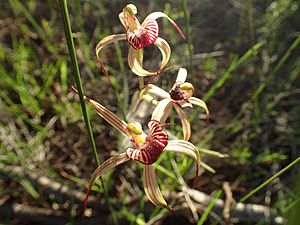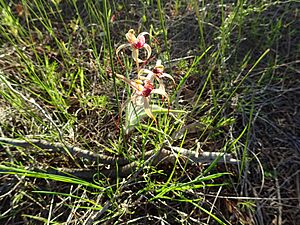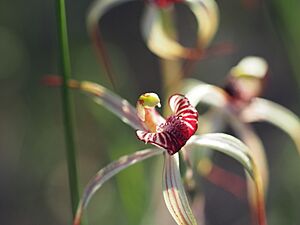Drooping spider orchid facts for kids
Quick facts for kids Drooping spider orchid |
|
|---|---|
 |
|
| Caladenia radialis growing near Badgingarra | |
| Scientific classification | |
| Genus: |
Caladenia
|
| Species: |
radialis
|
| Synonyms | |
|
|
The Drooping Spider Orchid (scientific name: Caladenia radialis) is a special type of orchid. It grows only in the south-west part of Western Australia. This means it's endemic to that area.
This unique plant has a single, upright, hairy leaf. It usually produces one or two beautiful red and cream-coloured flowers. After good rainfall, you might see it growing in groups of up to ten plants.
Contents
What Does the Drooping Spider Orchid Look Like?
The Drooping Spider Orchid is a perennial plant. This means it lives for more than two years. It's also a deciduous herb, which means its leaves fall off at certain times. It grows from an underground tuber, which is like a small storage root.
Each plant has one hairy leaf that stands up straight. This leaf can be about 5 to 18 centimeters (2 to 7 inches) long. The flowers are quite striking, measuring about 4 to 5 centimeters (1.5 to 2 inches) long and 4 to 8 centimeters (1.5 to 3 inches) wide. They grow on a stalk that can be 15 to 35 centimeters (6 to 14 inches) tall.
Flower Details
The flowers are red and cream-coloured. Their sepals and petals have long, brown, thread-like tips that droop downwards. The top sepal curves forward. The side sepals and petals are similar in size.
A special part of the flower is the labellum. This is the orchid's "lip." It's about 1.2 to 1.5 centimeters (0.5 to 0.6 inches) long and 0.8 to 1 centimeter (0.4 inches) wide. The labellum is cream-coloured with red lines. Sometimes, its sides have small teeth. The tip of the labellum curls under. There are also many red or cream-coloured bumps called calli along its middle.
You can usually see these orchids flowering from August to early October.
How Did It Get Its Name?
The Drooping Spider Orchid was first officially described in 1927. A scientist named Richard Rogers found a sample near a town called Dowerin. He published his description in a scientific journal.
The scientific name radialis comes from a Latin word. Radius means "ray," "rod," or "spoke." This name was chosen because of the red lines on the orchid's labellum, which look like rays spreading out.
Where Does It Grow?
This unique orchid is found in several areas of Western Australia. It grows between the Fitzgerald River National Park and Northampton. You can find it in different natural areas, including:
- The Avon Wheatbelt
- The Esperance Plains
- The Geraldton Sandplains
- The Jarrah Forest
- The Mallee region
It likes to grow in various places, such as on granite rocks and near the edges of salt lakes.
Is It Protected?
Good news! The Western Australian Government's Department of Parks and Wildlife has classified Caladenia radialis as "not threatened." This means it is not currently at risk of disappearing.



